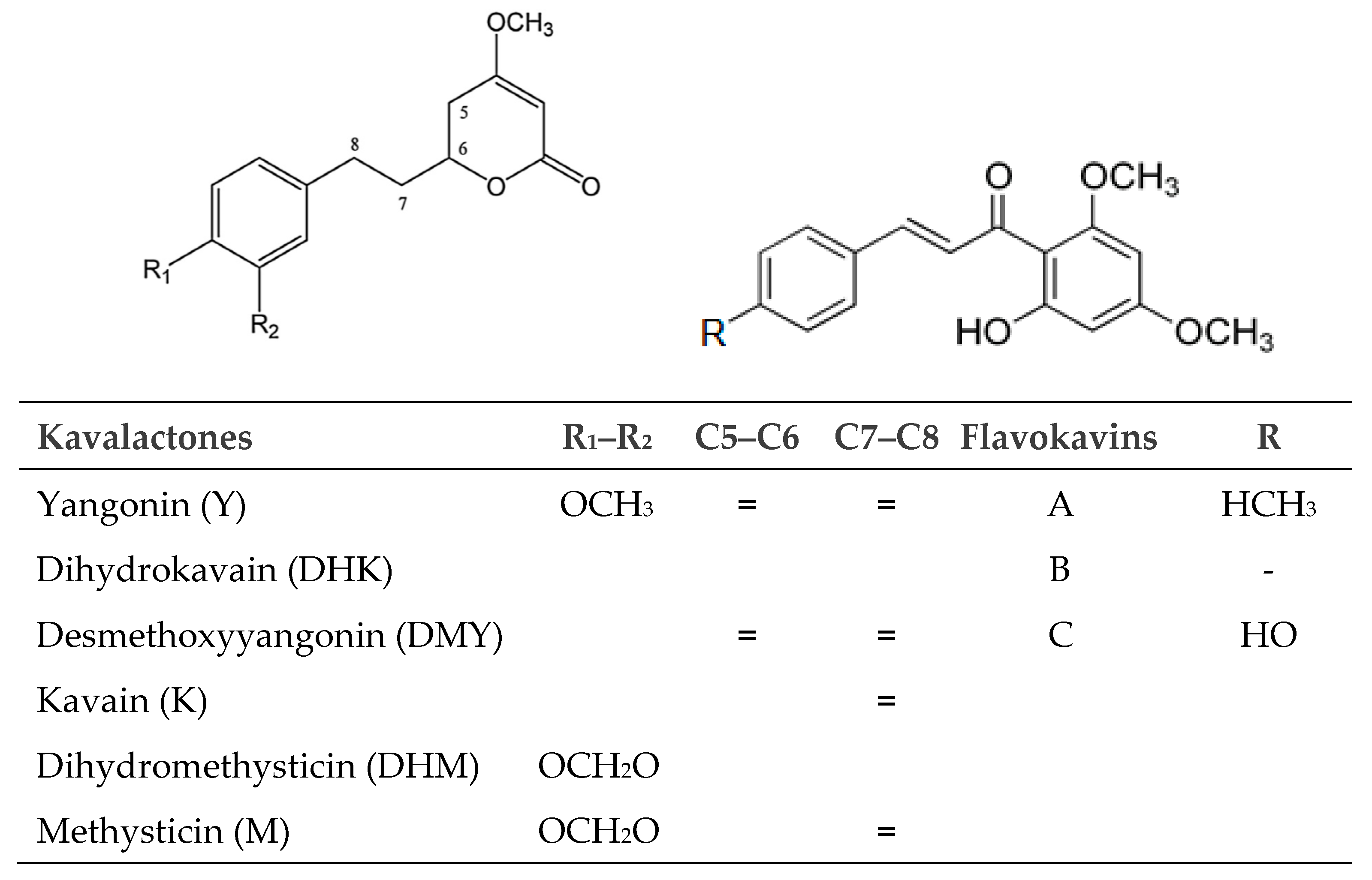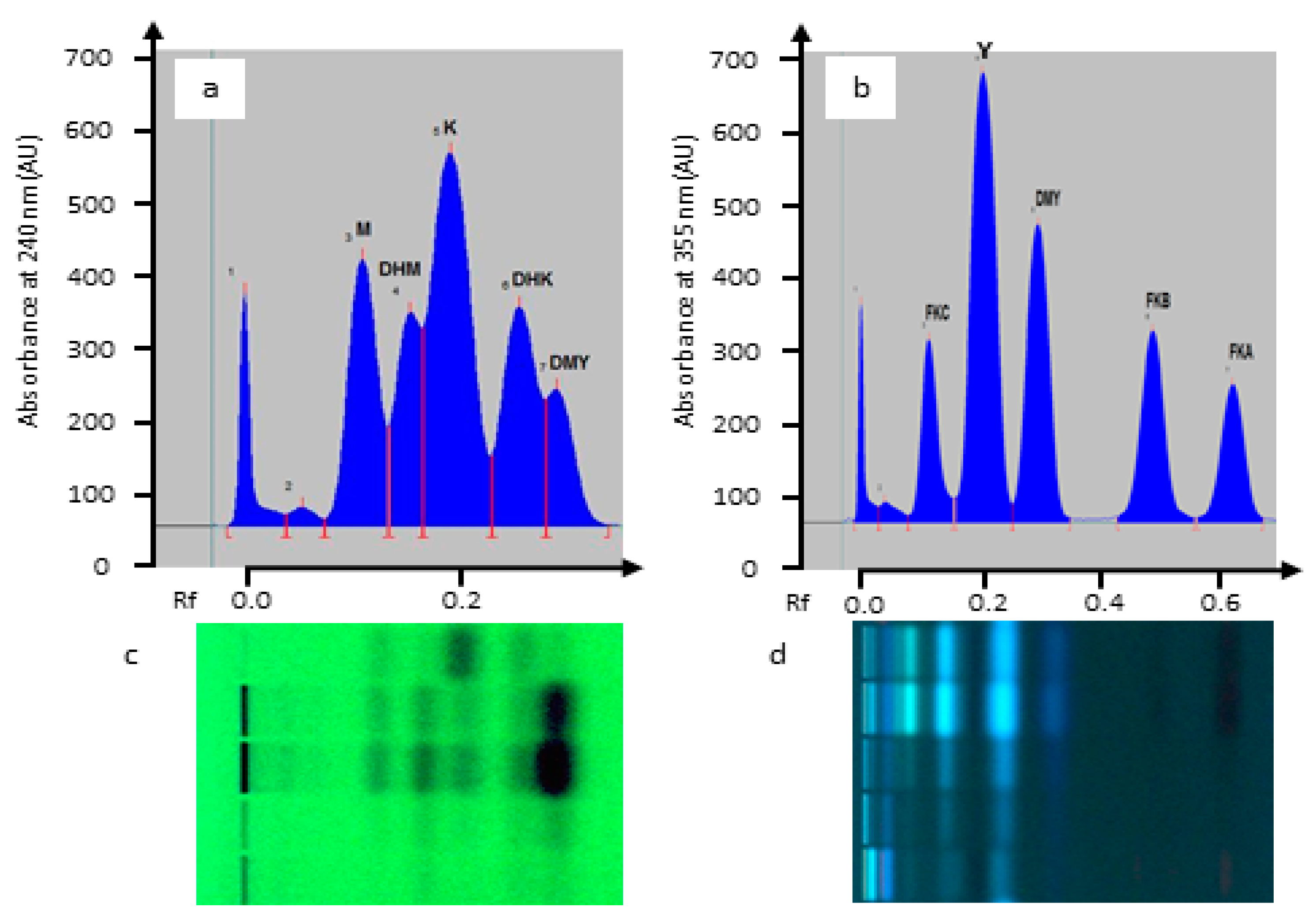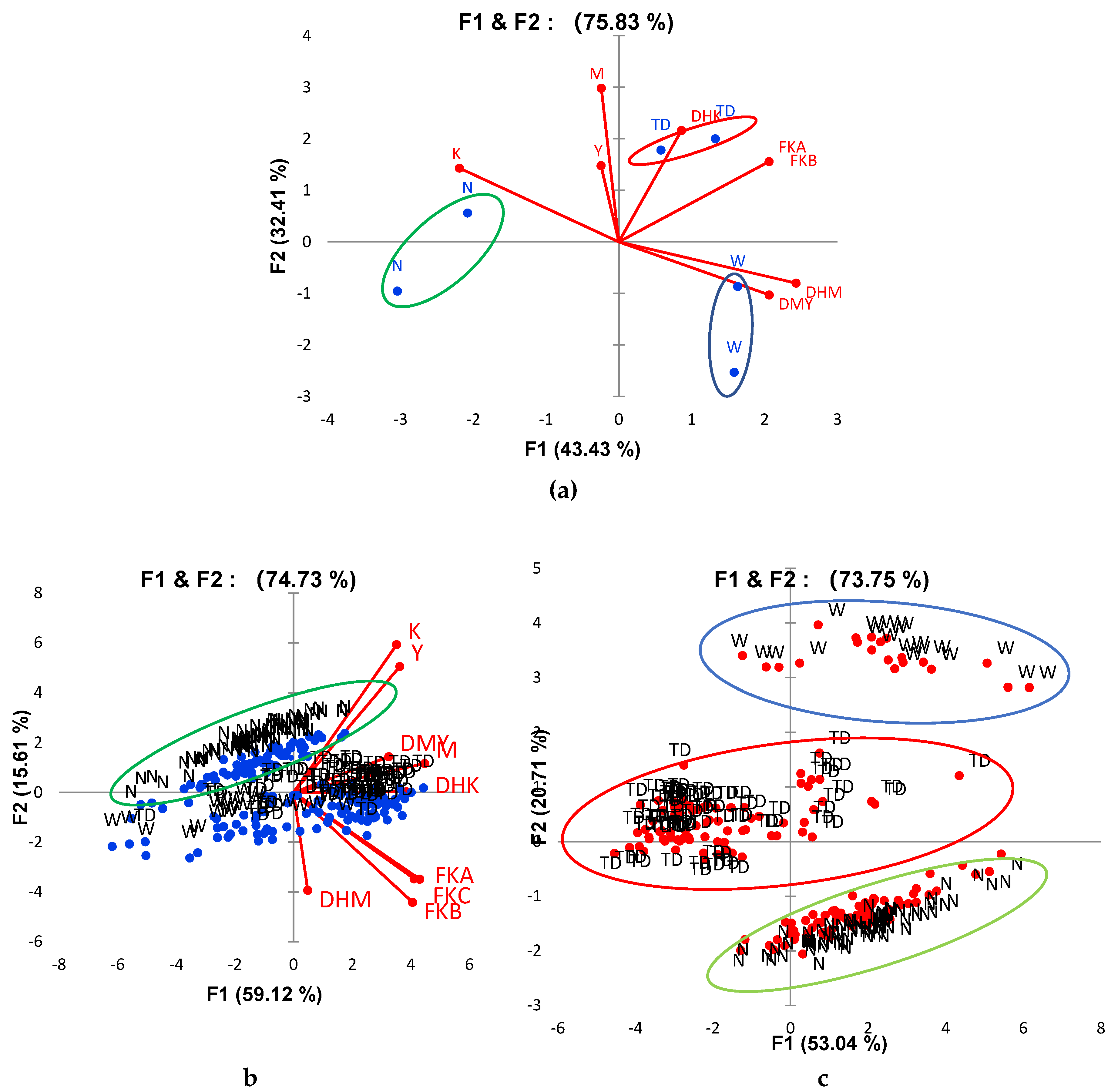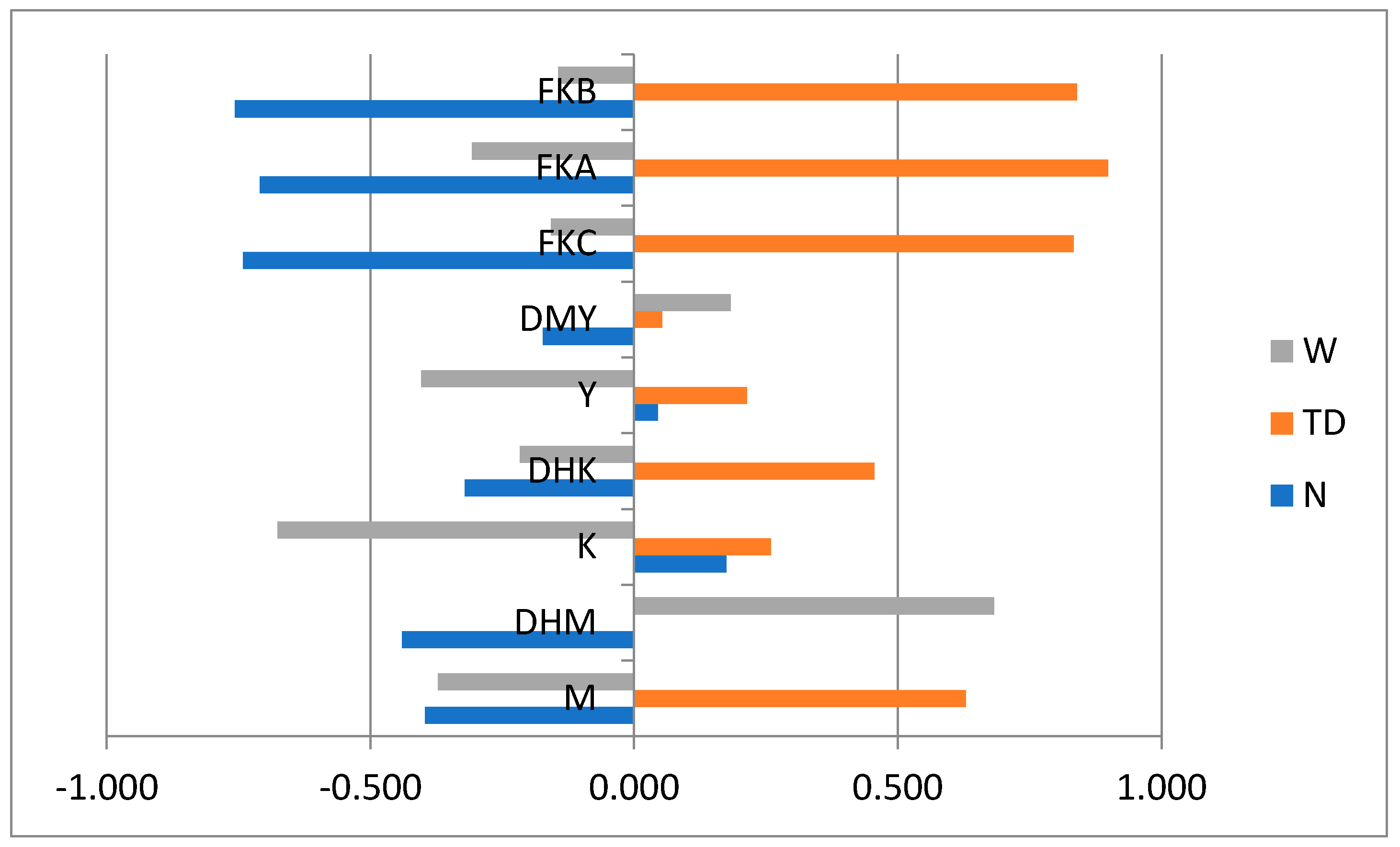Kavalactones and Flavokavins Profiles Contribute to Quality Assessment of Kava (Piper methysticum G. Forst.), the Traditional Beverage of the Pacific
Abstract
1. Introduction
2. Materials and Methods
2.1. Plant Materials
2.2. Preparation of Extracts and Standards
2.3. High Performance Thin Layer Chromatography (HPTLC)
2.4. Ultra High Performance Liquid Chromatography (UHPLC)
2.5. Statistical Analyses
3. Results and Discussion
3.1. Quantification of Individual Kavalactones and Flavokavins
3.2. Multivariate Analyses
3.3. Chemotypes
3.4. Implications for Quality Control
4. Conclusions
Supplementary Materials
Author Contributions
Funding
Acknowledgments
Conflicts of Interest
References
- Showman, A.F.; Baker, J.D.; Linares, C.; Naeole, C.K.; Borris, R.; Johnston, E.; Konanui, J.; Turner, H. Contemporary Pacific and Western perspectives on awa (Piper methysticum) toxicology. Fitoterapia 2015, 100, 56–67. [Google Scholar] [CrossRef] [PubMed]
- Fiji Kava Value Chain Analysis; Pacific Horticultural and Agricultural Market Access (PHAMA): Suva, Fiji, 2015; p. 124. Available online: http://phama.com.au/wp-content/uploads/2018/06/Fiji-Kava-Value-Chain-Analysis-Report-FINAL.pdf (accessed on 7 January 2019).
- Kuchta, K.; Schmidt, M.; Nahrstedt, A. German Kava Ban Lifted by Court: The Alleged Hepatotoxicity of Kava (Piper methysticum) as a Case of Ill-Defined Herbal Drug Identity, Lacking Quality Control and Misguided Regulatory Politics. Plant Med. 2015, 81, 1647–1653. [Google Scholar] [CrossRef]
- IARC Monograph. 2018, Volume 108. IARC-WHO, Lyon, France. Available online: https://monographs.iarc.fr/wp-content/uploads/2018/06/mono108-04.pdf (accessed on 14 January 2019).
- Republic of Vanuatu. Kava Act No. 2 of 2002; Government of the Republic of Vanuatu: Port-Vila, Vanuatu, 2002. Available online: http://www.paclii.org/vu/legis/num_act/toc-K.html (accessed on 8 January 2019).
- VandenBroucke, H.; Mournet, P.; Malapa, R.; Glaszmann, J.C.; Chair, H.; Lebot, V. Comparative analysis of genetic variation in kava (Piper methysticum) assessed by SSR and DArT reveals zygotic foundation and clonal diversification. Genome 2015, 58. [Google Scholar] [CrossRef]
- Lebot, V.; Lévèsque, J. Genetic control of kavalactone chemotypes in Piper methysticum cultivars. Phytochemistry 1996, 43, 397–403. [Google Scholar] [CrossRef]
- Bilia, A.; Scalise, L.; Bergonzi, M.; Vincieri, F. Analysis of kavalactones from Piper methysticum (kava-kava). J. Chromatogr. B 2004, 812, 203–214. [Google Scholar] [CrossRef]
- Zi, X.; Simoneau, A.R.; Flavokawain, A. A novel chalcone from kava extract, induces apoptosis in bladder cancer cells by involvement of bax protein-dependent and mitochondria-dependent apoptotic pathway and suppresses tumor growth in mice. Cancer Res. 2005, 65, 3479–3486. [Google Scholar] [CrossRef] [PubMed]
- Zhou, P.; Gross, S.; Liu, J.H.; Yu, B.Y.; Feng, L.L.; Nolta, J.; Sharma, V.; Piwnica-Worms, D.; Qiu, S.X. Flavokawain B, the hepatotoxic constituent from kava root, induces GSH-sensitive oxidative stress through modulation of IKK/NF-kappaB and MAPK signaling pathways. FASEB J. 2010, 24, 4722–4732. [Google Scholar] [CrossRef] [PubMed]
- Yeap, S.K.; Abu, N.; Akthar, N.; Ho, W.Y.; Ky, H.; Tan, S.W.; Alitheen, N.B.; Kamarul, T. Gene Expression Analysis Reveals the Concurrent Activation of Proapoptotic and Antioxidant-Defensive Mechanisms in Flavokawain B–Treated Cervical Cancer HeLa Cells. Integr. Cancer Ther. 2017, 16, 373–384. [Google Scholar] [CrossRef]
- Ji, T.; Lin, C.; Krill, L.S.; Eskander, R.; Guo, Y.; Zi, X.; Hoang, B.H.; Flavokawain, B. A kava chalcone, inhibits growth of human osteosarcoma cells through G2/M cell cycle arrest and apoptosis. Mol. Cancer 2013, 12, 55. [Google Scholar] [CrossRef]
- Teschke, R.; Sarris, J.; Schweitzer, I. Kava hepatotoxcity in traditional and modern use: The presumed Pacific kava paradox hypothesis revisited. Br. J. Clin. Pharmacol. 2012, 73, 170–174. [Google Scholar] [CrossRef]
- Olsen, L.R.; Grillo, M.P.; Skonberg, C. Constituents in kava extracts potentially involved in hepatotoxicity: A review. Chem. Res. Toxicol. 2011, 24, 992–1002. [Google Scholar] [CrossRef]
- Park, C.; Han, J.M. Anti-inflammatory Effects of Flavokavain C from Kava (Piper methysticum) Root in the LPS-induced Macrophages. J. Soc. Cosmet. Sci. Korea 2016, 42, 311–320. [Google Scholar]
- Martin, A.C.; Johnston, E.; Xing, C.; Hegeman, A.D. Measuring the Chemical and Cytotoxic Variability of Commercially Available Kava (Piper methysticum G. Forster). PLoS ONE 2014, 9, e111572. [Google Scholar] [CrossRef] [PubMed]
- Codex Alimentarius, Commission E. Discussion Paper on the Development of a Standard for Kava. In Proceedings of the Joint FAO/WHO Food Standards Programme, Thirteenth Session, Kokopo, Papua New Guinea, 19–22 September 2012; Available online: http://www.fao.org/tempref/codex/Meetings/CCNASWP/CCNASWP13/na13_08e.pdf (accessed on 7 January 2019).
- Wang, J.; Qu, W.; Jun, S.; Li, Q.X.; Bittenbender, H.C. Kavalactone content and chemotype of kava beverages prepared from roots and rhizomes of Isa and Mahakea varieties and extraction efficiency of kavalactones using different solvents. J. Food Sci. Technol. 2013, 52, 1164–1169. [Google Scholar] [CrossRef] [PubMed]
- Xuan, T.D.; Fukuta, A.A.; Wie, A.C.; Elzaawely, A.A.; Khanh, T.D.; Tawata, S. Efficacy of extracting solvents to chemical compounds of kava (Piper methysticum) root. J. Nat. Med. 2008, 62, 188–194. [Google Scholar] [CrossRef] [PubMed]
- Warburton, E.; Norris, P.L.; Goenaga-Infante, H. Comparison of the Capabilities of Accelerated Solvent Extraction and Sonication as Extraction Techniques for the Quantification of Kavalactones in Piper methysticum (Kava) Roots by High Performance Liquid Chromatography with Ultra Violet Detection. Phytochem. Anal. 2007, 18, 98–102. [Google Scholar] [CrossRef] [PubMed]
- Meissmer, O.; Häberlein, H. HPLC analysis of flavokavins and kavapyrones from Piper methysticum Forst. J. Chromatogr. B 2005, 826, 46–49. [Google Scholar] [CrossRef]
- Liu, Y.; Lund, J.A.; Murch, S.J.; Brown, P.N. Single-Lab Validation for Determination of Kavalactones and Flavokavains in Piper methysticum (Kava). Planta Med. 2018, 84. [Google Scholar] [CrossRef]
- Siméoni, P.; Lebot, V. Identification of factors determining kavalactones content and chemotype in kava (Piper methysticum Forst. f.). Biochem. Syst. Ecol. 2002, 30, 413–424. [Google Scholar] [CrossRef]
- FAO/WHO. Kava: A Review of the Safety of Traditional and Recreational Beverage Consumption; Technical Report; Food and Agriculture Organization of the United Nations World Health Organization: Rome, Italy, 2016; p. 35. [Google Scholar]
- Lebot, V.; Do, T.K.; Legendre, L. Detection of Flavokavins (A, B, C) in cultivars of kava (Piper methysticum) using HP-TLC. Food Chem. 2014, 151, 554–560. [Google Scholar] [CrossRef]
- Lhuissier, T.; Mercier, P.E.; Michalet, S.; Lebot, V.; Legendre, L. Colorimetric assessment of kava (Piper methysticum Forst.) quality. J. Food Compos. Anal. 2017, 59, 27–34. [Google Scholar] [CrossRef]
- Narayanapillai, S.C.; Leitzman, P.; O’Sullivan, M.G.; Xing, C. Flavokawains A and B in Kava, Not Dihydromethysticin, Potentiate Acetaminophen-Induced Hepatotoxicity in C57BL/6 Mice. Chem. Res. Toxicol. 2014, 27, 1871–1876. [Google Scholar] [CrossRef] [PubMed]
- Jhoo, J.W.; Freeman, J.P.; Heinze, T.M.; Moody, J.D.; Schnackenberg, L.K.; Beger, R.D.; Dragull, K.; Tang, C.S.; Ang, C.Y.W. In vitro cytotoxicity of nonpolar constituents from different parts of kava plant (Piper methysticum). J. Agric. Food Chem. 2006, 54, 3157–3162. [Google Scholar] [CrossRef] [PubMed]
- Backleh, M.; Ekici, P.; Leupold, G.; Parlar, H. Quantitative elimination of Flavokavines A and B from Kava Kava (Piper methysticum G. Forst.) by isoelectric focused adsorptive bubble separation. Naturwissenschaften 2003, 90, 366–369. [Google Scholar] [CrossRef] [PubMed]
- Kurth, H. Kava-Kava Chemical Analysis: Methods for Analytical Investigation of Active and Marker Components. Finzelgerg Presentation. Presented at the International Symposium on Kava and Other Medicinal Plants of the South Pacific, Kona, HI, USA, 14–17 May 1997. [Google Scholar]
- Saletu, B.; Grunberger, J.; Linzmayer, L.; Anderer, P. EEG-Brain Mappin Psychometric and Psychophysiological Studies on Central Effects of Kavain—A Kava Plant Derivative. Hum. Psychopharm. Clin. Exp. 1989, 4, 169–190. [Google Scholar] [CrossRef]
- Tsutsui, R.; Shinomiya, K.; Takeda, Y.; Obara, Y.; Kitamura, Y.; Kamei, C. Hypnotic and sleep quality-enhancing properties of kavain in sleep-disturbed rats. J. Pharmacol. Sci. 2009, 293–298. [Google Scholar] [CrossRef] [PubMed]
- Tarbak, F.A. Analytical studies on the kavain metabolism in human specimen and liver cell lines. Ph.D. Thesis, Forensic Toxicology Institut für Rechtsmedizin, Heinrich-Heine-Universität, Düsseldorf, Germany, 2004; pp. 89–92. [Google Scholar]
- Chua, H.C.; Christensen, E.T.H.; Hoestgaard-Jensen, K.; Hartiadi, L.Y.; Ramzan, I.; Jensen, A.A.; Absalom, N.L.; Chebib, M. Kavain, the Major Constituent of the Anxiolytic Kava Extract, Potentiates GABAA Receptors: Functional Characteristics and Molecular Mechanism. PLoS ONE 2016, 11, e0157700. [Google Scholar] [CrossRef]
- Schmidt, M.; Carreno, I.; Vergano, P. Technical Assistance to the Integration to the Multilateral Trading System and Support to the Integrated Framework; Ref. 9 ACP RPR 140-039/11: Establishment of Health and Safety Standards for the Production and Export of Kava-Based Products; ACP6EU-TBT: Brussels, Belgium, 14 March 2012. [Google Scholar]
- Teschke, R.; Wolff, A. Regulatory causality evaluation methods applied in Kava hepatotoxicity: Are they appropriate? Regul. Toxicol. Pharmacol. 2011, 59. [Google Scholar] [CrossRef]
- Abu, N.; Mohamed, N.E.; Yeap, S.K.; Lim, K.L.; Akhtar, M.N.; Zulfadli, A.J.; Kee, B.B.; Abdullah, M.P.; Omar, A.R.; Alitheen, N.B. In vivo antitumor and antimetastatic effects of flavokawain B in 4T1 breast cancer cell-challenged mice. Drug Des. Dev. Ther. 2015, 9, 1401–1417. [Google Scholar]
- Pinner, D.D.; Wales, C.T.K.; Gristock, R.A.; Vo, H.T.; So, N.; Jacobs, A.T. Flavokavins A and B from kava (Piper methysticum) activate heat shock and antioxidant responses and protect against hydrogen peroxide-induced cell death in HepG2 hepatocytes. Pharm. Biol. 2016, 54, 1503–1512. [Google Scholar] [CrossRef]
- Rossette, M.C.; Moraes, D.C.; Sacramento, E.K.; Romano-Silva, M.A.; Carvalho, J.L.; Gomes, D.A.; Caldas, H.; Friedman, E.; Bastos-Rodrigues, L.; De Marco, L. The In Vitro and In Vivo Antiangiogenic Effects of Flavokawain B. Phytother. Res. 2017, 31, 1607–1613. [Google Scholar] [CrossRef] [PubMed]




| Compound | Linear Equation | R2 | %RSD | |
|---|---|---|---|---|
| Desmethoxy yangonin | DMY | y = −6371.5x2 + 18248x + 192.53 | 0.9986 | 0.66 |
| Dihydrokavain | DHK | y = −1964.8x2 + 6264.1x + 139.46 | 0.9996 | 1.54 |
| Yangonin | Y | y = −3216.6x2 + 10984x + 466.08 | 0.9993 | 0.93 |
| Kavain | K | y = −5080.5x2 + 17784x + 949.51 | 0.9977 | 0.89 |
| Dihydromethysticin | DHM | y = 63.386x2 + 580.73x + 142.82 | 0.9982 | 2.61 |
| Methysticin | M | y = 126.34x2 + 898.66x + 559.52 | 0.9997 | 1.79 |
| Flavokavin A | FKA | y = 74.691x2 + 690.57x + 0.63 | 0.9991 | 1.01 |
| Flavokavin B | FKB | y = −33.325x2 + 1023.7x + 196.28 | 0.9999 | 0.52 |
| Flavokavin C | FKC | y = 80.65x2 + 653.67x − 147.66 | 0.9997 | 1.33 |
| Group | DMY (1) | DHK (2) | Y (3) | K (4) | DHM (5) | M (6) | FKA | FKB | FKC | Total KLs | Total FKs | KLs %DW | FKs/ KLs | K/ FKB |
|---|---|---|---|---|---|---|---|---|---|---|---|---|---|---|
| Nobles (n = 72) | ||||||||||||||
| Mean | 29.3 a | 23.5 b | 37.9 a | 36.4 a | 8.9 b | 13.7 b | 7.6 b | 6.0 c | 5.8 b | 149.9 b | 19.4 c | 15.0 | 0.13 c | 7.31 a |
| Std | 8.4 | 9.3 | 7.8 | 7.7 | 2.4 | 4.9 | 2.6 | 2.7 | 1.7 | 36.0 | 6.0 | 3.6 | 0.03 | 3.46 |
| Min | 8.2 | 3.7 | 15.3 | 11.4 | 2.8 | 2.8 | 2.1 | 0.9 | 1.1 | 48.6 | 5.1 | 4.9 | 0.07 | 2.85 |
| Max | 43.1 | 45.8 | 55.3 | 48.9 | 15.3 | 23.4 | 15.2 | 12.0 | 9.5 | 223.7 | 30.5 | 22.3 | 0.22 | 17.71 |
| %KLs + FKs | 17.1 | 13.8 | 22.8 | 21.7 | 5.3 | 7.9 | 4.5 | 3.5 | 3.4 | 88.6 | 11.4 | |||
| %KLs | 19.4 | 15.5 | 25.7 | 24.5 | 6.0 | 8.9 | ||||||||
| Two-Day (n = 82) | ||||||||||||||
| Mean | 31.6 a | 33.8 a | 39.4 a | 37.2 a | 13.3 b | 20.8 a | 24.0 a | 26.3 a | 14.3 a | 176.1 a | 64.6 a | 17.6 | 0.36 a | 1.50 b |
| Std | 6.6 | 9.9 | 5.9 | 8.3 | 3.3 | 4.5 | 5.2 | 7.7 | 3.0 | 31.8 | 15.3 | 3.2 | 0.05 | 0.42 |
| Min | 7.8 | 11.4 | 12.2 | 8.6 | 4.0 | 4.2 | 7.2 | 7.0 | 3.3 | 51.8 | 17.6 | 5.2 | 0.25 | 0.69 |
| Max | 41.2 | 49.9 | 49.1 | 50.7 | 23.7 | 27.6 | 32.7 | 37.5 | 19.2 | 229.5 | 85.7 | 23.0 | 0.54 | 2.96 |
| % KLs + FKs | 13.1 | 13.9 | 16.6 | 15.4 | 5.7 | 8.6 | 10.0 | 10.7 | 5.9 | 73.3 | 26.7 | |||
| %KLs | 17.9 | 19.0 | 22.6 | 21.0 | 7.8 | 11.8 | ||||||||
| Wichmannii (n = 20) | ||||||||||||||
| Mean | 35.5 a | 20.9 b | 28.3 b | 14.5 b | 29.4 a | 10.2 b | 7.5 b | 11.7 b | 7.9 b | 138.8 c | 27.2 b | 13.9 | 0.21 b | 1.70 b |
| Std | 13.9 | 16.7 | 11.8 | 6.2 | 15.7 | 5.3 | 2.6 | 6.9 | 3.6 | 55.6 | 12.2 | 5.6 | 0.18 | 1.66 |
| Min | 12.5 | 2.6 | 5.8 | 2.5 | 6.5 | 0.6 | 2.2 | 2.4 | 1.5 | 34.3 | 7.2 | 3.4 | 0.03 | 0.43 |
| Max | 59.3 | 56.1 | 47.0 | 22.2 | 54.4 | 18.6 | 11.9 | 27.7 | 14.5 | 213.9 | 54.1 | 21.4 | 0.54 | 7.95 |
| % KLs + FKs | 21.9 | 11.6 | 17.0 | 8.6 | 17.8 | 5.9 | 4.9 | 7.4 | 5.0 | 87.7 | 17.3 | |||
| %KLs | 26.7 | 14.2 | 20.5 | 10.3 | 21.2 | 7.1 | ||||||||
| N | TD | W | M | DHM | K | DHK | FKC | Y | DMY | FKA | |
|---|---|---|---|---|---|---|---|---|---|---|---|
| TD | −0.792 ** | ||||||||||
| W | −0.302 ** | −0.343 ** | |||||||||
| M | −0.404 ** | 0.636 ** | −0.372 ** | ||||||||
| DHM | −0.437 ** | −0.007ns | 0.683 ** | 0.102ns | |||||||
| K | 0.173ns | 0.263ns | −0.676 ** | 0.773 ** | −0.306 ** | ||||||
| DHK | −0.320 ** | 0.455 ** | −0.218ns | 0.630 ** | 0.037ns | 0.547 ** | |||||
| FKC | −0.742 ** | 0.833 ** | −0.160ns | 0.794 ** | 0.113ns | 0.427 ** | 0.688 ** | ||||
| Y | 0.036ns | 0.222ns | −0.403 ** | 0.797 ** | 0.123ns | 0.853 ** | 0.547 ** | 0.448 ** | |||
| DMY | −0.179ns | 0.057ns | 0.186ns | 0.563 ** | 0.334 ** | 0.465 ** | 0.573 ** | 0.502 ** | 0.634 ** | ||
| FKA | −0.709 ** | 0.898 ** | −0.311ns | 0.769 ** | 0.039ns | 0.460 ** | 0.610 ** | 0.922 ** | 0.421 ** | 0.322 ** | |
| FKB | −0.755 ** | 0.837 ** | −0.146ns | 0.719 ** | 0.100ns | 0.364 ** | 0.641 ** | 0.946 ** | 0.321 ** | 0.440 ** | 0.952 ** |
© 2019 by the authors. Licensee MDPI, Basel, Switzerland. This article is an open access article distributed under the terms and conditions of the Creative Commons Attribution (CC BY) license (http://creativecommons.org/licenses/by/4.0/).
Share and Cite
Lebot, V.; Michalet, S.; Legendre, L. Kavalactones and Flavokavins Profiles Contribute to Quality Assessment of Kava (Piper methysticum G. Forst.), the Traditional Beverage of the Pacific. Beverages 2019, 5, 34. https://doi.org/10.3390/beverages5020034
Lebot V, Michalet S, Legendre L. Kavalactones and Flavokavins Profiles Contribute to Quality Assessment of Kava (Piper methysticum G. Forst.), the Traditional Beverage of the Pacific. Beverages. 2019; 5(2):34. https://doi.org/10.3390/beverages5020034
Chicago/Turabian StyleLebot, Vincent, Serge Michalet, and Laurent Legendre. 2019. "Kavalactones and Flavokavins Profiles Contribute to Quality Assessment of Kava (Piper methysticum G. Forst.), the Traditional Beverage of the Pacific" Beverages 5, no. 2: 34. https://doi.org/10.3390/beverages5020034
APA StyleLebot, V., Michalet, S., & Legendre, L. (2019). Kavalactones and Flavokavins Profiles Contribute to Quality Assessment of Kava (Piper methysticum G. Forst.), the Traditional Beverage of the Pacific. Beverages, 5(2), 34. https://doi.org/10.3390/beverages5020034





